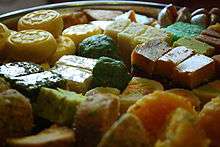Vark
|
Indian sweets garnished with vark | |
| Alternative names | Varq, vark, varak, varakh, varakha etc. |
|---|---|
| Type | Garnish |
| Place of origin | Indian Subcontinent |
| Region or state | South Asia |
| Main ingredients | Silver, Gold |
|
| |

Vark, also called varak (also silver leaf, German paper) is any leaf composed of pure metals, typically silver but sometimes gold,[1] used on South Asian sweets. The silver is edible, though flavorless. Varak is made by pounding silver into sheets, a few micrometres (µ) thick, typically 0.2 micron to 0.8 microns. The sheets are typically backed with paper for support; this paper is peeled away before use. It is fragile and breaks into smaller pieces if handled with direct skin contact. Those leaves in the 0.2 micron thickness tend to adhere to skin if handled directly (due to thickness close to inter-atomic distance). Vark sheets are laid or rolled over some South Asian sweets. Edible silver and gold foils on sweets, confectionery and desserts is not unique to the Indian subcontinent; other regions such as Japan and Europe have long used precious metal foils as food cover and as decoration, including specialty drinks such as Danziger Goldwasser.[1] It is also commonly used in India as coating on dry fruits (such as almonds, cashews, and dates), and in sugar balls, betel nuts, cardamom and other spices. Cardamom-coated sweets are very commonly present in the market. Concerns have been raised about the safety and ethical acceptability of Vark, as not all of it is pure silver, nor hygienically prepared, and the foil nowadays commonly is beaten between layers of ox-gut because it is easier to separate the silver leaf from animal tissue than to separate it from paper. It is considerable that some technologies evolved for the production of silver leaves i.e. in Russia, German, China and India. Technologies like beating over sheets of black special treated paper, polyester sheets coated with food grade calcium powder are used instead of ox-guts. Estimated consumption of Vark is 275 tons (according to BWC-Beauty without cruelty data) annually. Hindu and Jain religions are mostly vegetarian, thus the Indian market for Vark has mostly converted to using the vegetarian process in the making of the silver leaves.
Safety
Gold and silver are approved food foils in the European Union, as E175 and E174 additives respectively. The independent European food-safety certification agency, TÜV Rheinland, has deemed gold leaf safe for consumption. Gold and silver leaf are also certified as kosher. These inert precious metal foils are not considered toxic to human beings nor to broader ecosystems.[2][3]
One study has found that about 10% of 178 foils studied from the Lucknow (India) market were made of aluminium. Of the tested foils, 46% of the samples were found to have the desired purity requirement of 99.9% silver, whereas the rest had less than 99.9% silver. All the tested Indian foils contained on average trace levels of nickel (487 ppm), lead (301 ppm), copper (324 ppm), chromium (83 ppm), cadmium (97 ppm) and manganese (43 ppm). All of these are lower than natural anthropogenic exposures of these metals; the authors suggest there is a need to address a lack of purity standards in European Union and Indian food additive grade silver.[4][5] The total silver metal intake per kilogram of sweets eaten, from vark, is less than one milligram.
Large quantities of ingested bioactive silver can cause argyria, but the use of edible silver or gold as vark is not considered harmful to the body, since the metal is in inert form (not ionic bioactive form), and the quantities involved in normal use are minuscule.[6]
However, while silver leaf may be safe to ingest, there is a risk of disease, due to the fact that the silver is initially hammered under rather unsanitary conditions.
Etymology and origins

Varaka is mentioned in several ancient Sanskrit documents, particularly in Ayurvedic and medical literature. Varaka means cloth, cloak or a thing that covers something else. The word varaka is mentioned with swarna (gold), tara (silver) or rupera (silver) in these documents; the discussion is in three forms of these precious metals: patra (leaf), varaka (thin foil) and bhasma (ash). Ayurvedic documents consider silver as an antimicrobial astringent, while gold is claimed to be an aphrodisiac. This is not unique to Indian subcontinent; in Europe, edible gold (Aureum potabile) and silver were also claimed to have medicinal properties; later studies found that they can indeed be antibacterial owing to Oligodynamic effect.
Vark is sometimes spelled Varaq, varq, vark, varkh, varakh, varkha, or waraq (Hindi: वरक़, Urdu: ورق Hindustani pronunciation: [ʋəɾəq]).
See also
References
- 1 2 Gold in Gastronomy deLafee, Switzerland (2008)
- ↑ Conspicuous Consumption L.V. Anderson, Slate (July 16, 2012)
- ↑ Public Health Statement for Silver ATSDR-CDC, US Government (December 1990)
- ↑ Das, Mukul; Dixit, S.; Khanna, S. K. (2005). "Justifying the need to prescribe limits for toxic metal contaminants in food-grade silver foils". Food Additives & Contaminants. 22 (12): 1219. doi:10.1080/02652030500215235.
- ↑ Agency for Toxic Substances and Disease Registry, See toxicity, food and exposure papers on nickel, lead, copper, chromium, cadmium and manganese.
- ↑ Sarvate, Sarita (4 April 2005). "Silver Coating". India Currents. Retrieved 2009-07-05.
